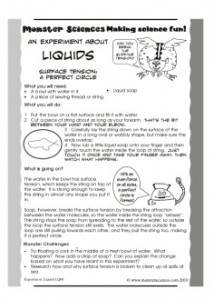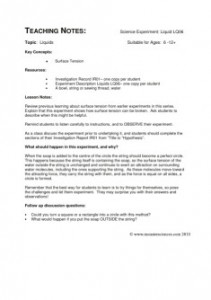Watch how the silly string reacts when you break the tension! A surface tension experiment.
 |
 |
Monster Sciences Liquids Experiment: Silly String
What you will need:
- A bowl with water in it
- A piece of sewing thread or string
- Liquid soap
What you will do:
- Put the bowl on a flat surface and fill it with water.
- Cut a piece of string about as long as your forearm. That’s the bit between your hand and your elbow.
- Carefully lay the string down on the surface of the water in a long oval or wobbly shape, but make sure the ends overlap.
- Now rub a little liquid soap onto your finger and then gently touch the water inside the loop of string. Just touch it once and take your finger away, then watch what happens.
What is going on?
The water in the bowl has surface tension, which keeps the string on top of the water. It is strong enough to keep the string in almost any shape you put it in.
Soap, however, breaks the surface tension by breaking the attraction between the water molecules, so the water inside the string loop “relaxes”. The string stops the soap from spreading to the rest of the water, so outside the loop the surface tension still exists. The water molecules outside the loop are still pulling towards each other, and they pull the string too, making it a perfect circle.
Monster Challenges:
- Try floating a cork in the middle of a fresh bowl of water. What happens? Now add a drop of soap? Can you explain the change based on what you have learnt in this experiment?
- Research how and why surface tension is broken to clean up oil spills at sea.
Teaching Notes: Monster Science Experiment: Liquid LQ06
Topic:
Liquids
Key Concepts:
Surface Tension
Resources:
- Investigation Record IR01– one copy per student
- Experiment Description Liquids LQ06– one copy per student
- A bowl, string or sewing thread, water
Lesson Notes:
Review previous learning about surface tension from earlier experiments in this series. Explain that this experiment shows how surface tension can be broken. Ask students to describe when this might be helpful.
Remind students to listen carefully to instructions, and to OBSERVE their experiment.
As a class discuss the experiment prior to undertaking it, and students should complete the sections of their Investigation Report IR01 from ”Title to “Hypothesis”.
What should happen in this experiment, and why?
When the soap is added to the centre of the circle the string should become a perfect circle. This happens because the string itself is containing the soap, so the surface tension of the water outside the string is unchanged and continues to exert an attraction on surrounding water molecules, including the ones supporting the string. As these molecules move toward the attracting force, they carry the string with them, and as the force is equal on all sides, a circle is formed.
Remember that the best way for students to learn is to try things for themselves, so pose the challenges and let them experiment. They may surprise you with their answers and observations!
Follow up discussion questions:
- Could you turn a square or a rectangle into a circle with this method?
- What would happen if you put the soap OUTSIDE the string?


